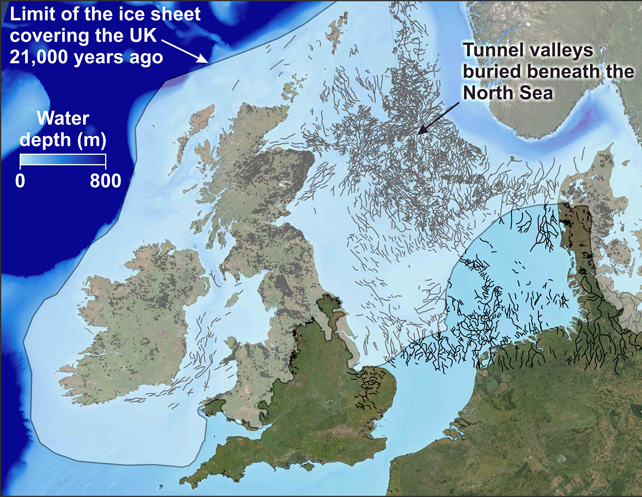A new study shows that hidden valleys were quickly carved out during the "death throes" of an ancient ice sheet in the North Sea.
Researchers say that the subterranean structures could yield clues as to how modern ice sheets will react to climate change.
The buried structures are massive underground ravines that were etched into the ancient seafloor by meltwater that drained into channels beneath the ice sheets.
The enormous weight of the rapidly melting slabs of ice forced the water to cut deep canyons into the seafloor.
According to a statement by researchers, tunnel valleys can be as long as 150 kilometers and as wide as 6 kilometers.
During the last ice age, between 126,000 to 12,000 years ago, parts of Europe and the UK were covered by a huge ice sheet in the North Sea.
Thousands of buried canyons, some of which date back 2 million years, were discovered using 3D seismic reflection technology. The results were published in the journal geology.
The researchers used canyon maps and computer models to figure out how some of the tunnel valleys were created.
The results showed that the tunnels may have been carved out in a few centuries.
Scientists are jumping for joy after discovering a hidden world under the ice.
This is a great discovery. The valleys are carved out during the death throes of ice sheets according to the study lead author.
Extreme warmth can cause tunnel valleys to be eroded quickly.
The creation of these channels has been shrouded in mystery, despite scientists knowing about them for decades.
"We have been observing these huge meltwater channels from areas covered by ice sheets for more than a century, but we did not really understand how they formed," study co-author Kelly Hogan said.

When meltwater goes through cracks in the ice into a river below the ice sheet, it forms tunnel valleys.
Increased summer melting leads to more meltwater that causes the valley's growth to be accelerated.
Although the tunnel valleys form toward the end of an ice sheet's life, the study authors believe that this drainage system may have extended the life span of the ancient North Sea ice sheet.
By draining meltwater away from the ice sheets, the channels stopped liquid from pooling on top of or below the ice and thus prevented more ice from melting.
The researchers don't know how fast the ice sheet was melting. Evidence of limited ice movement can be seen in some tunnel valleys.
The valleys could be having the opposite effect of increasing the ice loss rate according to the statement.
Scientists will continue to study the tunnel valleys to see if they can find the bottom of the meltwater channels.
Will the extra meltwater flow in channels cause our ice sheets to flow faster or slower into the sea? Hogan made a statement.
The answer to this question is critical for predicting how climate change will affect ice sheets.
Current models that predict the rate of ice loss don't take into account tunnel valleys, which means researchers are missing a crucial piece of the puzzle.
It could change how fast ice sheets melt if new tunnel valleys form below them, because they only take a few hundred years to form.
Kirkham said that the pace at which giant channels can form is an important mechanism.
There are related content.
The original article was published by Live Science. The original article can be found here.